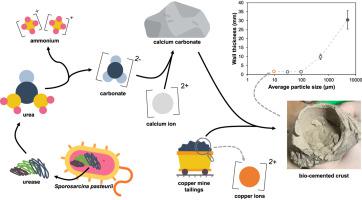Journal of Environmental Management ( IF 8.7 ) Pub Date : 2021-08-02 , DOI: 10.1016/j.jenvman.2021.113440 D de Oliveira 1 , Emma J Horn 1 , D G Randall 1

|
The solidification of copper mine tailings was investigated by using the natural biological process known as microbial induced calcium carbonate precipitation (MICP) as a potential method to valorize this waste stream. A submergent method was used to grow bio-columns and the toxicity of copper on Sporosarcina pasteurii (the ureolytic bacteria which drives the MICP process) was investigated. The bio-columns produced from copper mine tailings had a compressive strength of 0.54 MPa, lower than bio-columns produced from beach sand (1.85 MPa). The low porosity of the copper mine tailings limited the depth to which the MICP reaction could successfully occur, resulting in a 1.8 mm ± 0.4 mm crust forming around the outer extremities of the bio-columns. The results demonstrated that the particle size was a key deciding factor and that, as a result, MICP is not suitable for producing ‘thick’ bio-cemented materials from small particles (<100 μm) such as mine tailings. However, this method could produce thinner material such as bio-tiles or it could even be used to potentially cement together toxic dust particles typically formed on mine tailing heaps.
中文翻译:

微生物诱导碳酸钙沉淀法使铜尾矿增值
通过使用称为微生物诱导碳酸钙沉淀 (MICP) 的自然生物过程作为一种潜在的方法来评估铜矿尾矿的固化。用浸没法生长生物柱和铜对巴氏孢子菌的毒性(驱动 MICP 过程的尿素分解细菌)进行了研究。铜尾矿生产的生物柱的抗压强度为0.54 MPa,低于海滩砂生产的生物柱(1.85 MPa)。铜矿尾矿的低孔隙度限制了 MICP 反应成功发生的深度,导致在生物柱的外端周围形成 1.8 毫米 ± 0.4 毫米的外壳。结果表明,粒度是一个关键的决定因素,因此,MICP 不适合由小颗粒(<100 μm)(如尾矿)生产“厚”生物胶结材料。然而,这种方法可以生产更薄的材料,例如生物瓷砖,甚至可以用来潜在地将通常在矿山尾矿堆上形成的有毒粉尘颗粒粘合在一起。


























 京公网安备 11010802027423号
京公网安备 11010802027423号